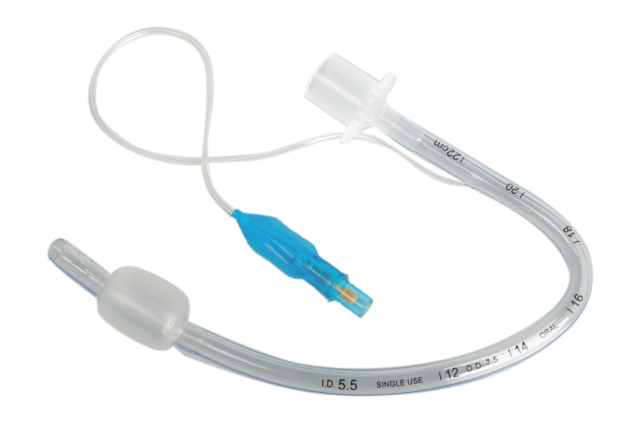Oral Preformed Tracheal Tube, Cuffed
Oral Preformed Tracheal Tube, Cuffed
High volume low pressure cuff
There are two main types of oral preformed tracheal tubes: cuffed and uncuffed. Cuffed tubes have a small balloon at the end that can be inflated to help keep the tube in place and prevent it from moving around. Uncuffed tubes do not have this balloon, and are typically used for shorter procedures.
Description
- Be used of oral intubation
- Responsive pilot balloons.
- Finely heat-welded cuffs (cuffed versions).
- Bull-nose tips.
- Split-resistant radiopaque lines.
- Smooth Murphy eye.
- Kink-resistant thermosensitive tube.
| Ref. No.: |
Size: |
Qty. Cs: |
| NMR100530 |
3.0 |
100 |
| NMR100535 |
3.5 |
100 |
| NMR100540 |
4.0 |
100 |
| NMR100545 |
4.5 |
100 |
| NMR100550 |
5.0 |
100 |
| NMR100555 |
5.5 |
100 |
| NMR100560 |
6.0 |
100 |
| NMR100565 |
6.5 |
100 |
| NMR100570 |
7.0 |
100 |
| NMR100575 |
7.5 |
100 |
| NMR100580 |
8.0 |
100 |
| NMR100585 |
8.5 |
100 |
| NMR100590 |
9.0 |
100 |
| NMR100595 |
9.5 |
100 |
| NMR100510 |
10.0 |
100 |
Oral Preformed Tracheal Tube, Cuffed
Types of Oral Preformed Tracheal Tubes
There are two main types of oral preformed tracheal tubes: cuffed and uncuffed. Cuffed tubes have a small balloon at the end that can be inflated to help keep the tube in place and prevent it from moving around. Uncuffed tubes do not have this balloon, and are typically used for shorter procedures.
Advantages and Disadvantages of Oral Preformed Tracheal Tubes
When it comes to intubation, there are a few different options available. One option is an oral preformed tracheal tube, also known as an OPTT. This type of tube is inserted through the mouth and into the trachea, and it can be used for both short-term and long-term intubation. In some cases, it may be the preferred method over other types of intubation, such as Nasotracheal intubation (NTI).
There are a few advantages of using an OPTT. One advantage is that it is less likely to cause trauma to the patient than NTI. It is also easier to place and secure an OPTT than other types of tubes. Additionally, patients who are intubated with an OPTT tend to have fewer complications than those who are intubated with other types of tubes.
There are also a few disadvantages of using an OPTT. One disadvantage is that it can be more difficult to place in some patients, such as those who have a small mouth or teeth that get in the way. Additionally, patients who are intubated with an OPTT may be at a higher risk for developing aspiration pneumonia
What to Consider When Choosing an Oral Preformed Tracheal Tube
When it comes to choosing an oral preformed tracheal tube, there are a few things you need to take into consideration. First and foremost, you need to make sure that the tube is the right size for your patient. The tube should also be cuffed in order to provide a seal and prevent leakage. Additionally, you will need to choose a tube with the appropriate connector for your ventilation system. Lastly, you should consider the material of the tube itself and make sure it is compatible with your patient's needs.
Oral Preformed Tracheal Tube - Cuffed online from Nexgen Medical Company, Be used of oral intubationResponsive pilot balloons. Finely heat-welded cuffs (cuffed versions), Bull-nose tips, Split-resistant radiopaque lines, Smooth Murphy eye, Kink-resistant thermosensitive tube.

The
distinguishing feature of RAE tubes in comparison to 'standard' ET tubes is their different
pre-formed bend. The pre-forming during manufacturing reduces the risk of kinking and obstruction which could occur if a 'standard' ET tube was bent into the same shape as an RAE tube. A
black marker bar is imprinted on the tube at the point of maximum angle of the bend (see pictures below).
RAE
endotracheal tubes are otherwise designed the same way as 'standard' orotracheal tubes, i.e. they have the same left-facing beveled tip, Oral Preformed Tracheal Tube Murphy eye, cuff design, and length/ diameter markings.
Oral RAE tubes are also described as
'south-facing', i.e. the tube connector facing towards the patient's feet after placement, while nasal
RAE tubes are also known as
'north-facing', i.e. the tube connector facing towards the patient's head after placement.
Oral RAE tube
The indications for placing an oral RAE tube are purely surgical, i.e. its use removes the tube connector and anesthetic breathing circuit from the surgical field or access to the surgical field.
Nasal RAE tube
Again, the indications for placing this type of ET tube are mainly surgical as described above. The nasal RAE tube is also the 'go-to' device for many practitioners when performing an
(awake) nasal fiberoptic intubation.
Disadvantages of the RAE tube
One disadvantage of the nasal (and even more so the oral) RAE tube is that
depth of tube insertion is very much pre-determined by the tube's pre-formed shape, i.e. the bend of the oral and nasal RAE will always want to sit just at the lower lip and at the nostril respectively, not allowing you much flexibility as to how deeply you can place the tube into the trachea. In some patients, especially very tall or short ones, it might be
difficult to achieve a good tube 'fit' together with the correct insertion depth which avoids accidental bronchial intubation or cuff placement between the vocal cords.
